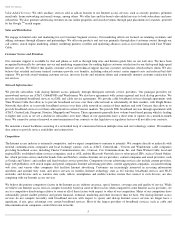Earthlink 2014 Annual Report Download - page 20
Download and view the complete annual report
Please find page 20 of the 2014 Earthlink annual report below. You can navigate through the pages in the report by either clicking on the pages listed below, or by using the keyword search tool below to find specific information within the annual report.
Table of Contents
workforce reductions, impairment of assets, facility consolidation and the elimination of revenues along with associated costs, any of which
could cause our operating results to decline and may fail to yield the expected benefits.
If we are unable to adapt to changes in technology and customer demands, we may not remain competitive, and our revenues and operating
results could suffer.
We operate in an industry characterized by changing technology, changes in customer needs and frequent new service and product introductions.
In addition, our strategy to become a leading managed network services provider is due, in part, to recent changes in technology, such as the
adoption of cloud computing and Software-as-a-
Service, and due to changes in customer demands, such as the increased demand for data and the
increased use of outsourcing. Our success will depend, in part, on our ability to use leading technologies effectively, to continue to develop our
technical expertise, to enhance our existing services and to develop new services that meet changing customer needs on a timely and cost-
effective basis. We may not be able to adapt quickly enough to changing technology, customer requirements and industry standards. If the
technology choices we make prove to be incorrect, ineffective or unacceptably costly, we may not be able to compete effectively. In addition,
new technologies may be protected by patents or other intellectual property laws, and, therefore, may be available only to our competitors. Any
of these items could adversely affect our business, results of operations and cash flows.
We may be unable to successfully divest non-strategic products, which could adversely affect our results of operations.
We are considering the divestiture of non-
strategic products, assets or customers based on management's assessment of their strategic value to
our business and in order to use the proceeds of divestiture transactions to reduce debt. Divesting certain of our products or assets would be
complex operationally due to their interrelationships with assets and products we would desire to retain. Any divestiture also would need to be
transacted in accordance with the terms of our debt agreements. There can be no assurance that we will identify appropriate transactions on terms
acceptable to us or that we will consummate a transaction in our expected timeframe. Additionally, decisions to divest certain business
operations could involve the expenditure of capital, consumption of management resources, realization of losses, transition and wind-
up
expenses, workforce reductions, impairment of assets and the elimination of revenues along with associated costs, any of which could cause our
operating results to decline and may fail to yield the expected benefits.
We may be unable to successfully make or integrate acquisitions, which could adversely affect our results of operations.
We may continue to evaluate and consider potential strategic transactions in order to grow our business. Small acquisitions may be required for
targeted capability building. At any given time, we may be engaged in discussions or negotiations with respect to one or more of such
transactions that may be material to our financial condition and results of operations. There can be no assurance that any such discussions or
negotiations will result in the consummation of any transaction, or that we will identify appropriate transactions on terms acceptable to us.
Adverse capital markets conditions could also negatively impact our ability to make acquisitions. Future acquisitions may result in significant
costs and expenses and charges to earnings, including those related to severance, employee benefit costs, retention costs for executive officers
and key employees, asset impairment charges, integration costs, charges from the elimination of duplicative facilities and contracts, unexpected
liabilities, legal, accounting and financial advisory fees.
Our ability to achieve the benefits of acquisitions depends in part on the successful integration and leveraging of technology, operations, sales
and marketing channels and personnel. Integration and other risks associated with acquisitions can be more pronounced for larger and more
complicated transactions or if multiple transactions are integrated simultaneously. The challenges and risks involved in the integration of our
acquired businesses, as well as any future businesses that we may acquire, include:
15
•
diversion of management's attention and resources that would otherwise be available for the current operation of our business;
•
failure to fully achieve expected synergies and costs savings or anticipated benefits may take longer;
•
higher integration costs than anticipated;
•
the impact on employee morale and the retention of employees, many of whom may have specialized knowledge about the
business;
•
lost revenues or opportunities as a result of our current or potential customers or strategic partners deciding to delay or forego
business;
•
difficulties combining product offerings and entering into new markets in which we are not experienced;
•
difficulties integrating the sales organizations of acquired companies;
•
the integration of departments, operating support systems, such as provisioning and billing systems, and technologies, such as
network equipment; and
























